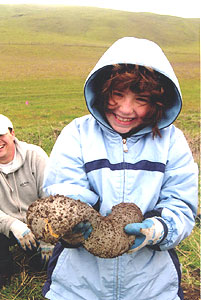 All last week my partner and I savored a ratatouille made from a rather large and unique zucchini. What made this particular zucchini special? The answer has to do with soil enzymes, deforestation, and Skippy peanut butter.
All last week my partner and I savored a ratatouille made from a rather large and unique zucchini. What made this particular zucchini special? The answer has to do with soil enzymes, deforestation, and Skippy peanut butter.
My zucchini began its life in a bountiful test garden at the DriWater factory in Santa Rosa, from where I picked it during a recent tour of the facility. DriWater is a rather ingenious local invention—a gelatinous substance consisting of 98% water and 2% cellulose gum-- that is used for time-release irrigation.
I visited the factory along with staff and participants from our Students and Teachers Restoring a Watershed (STRAW) Project, who use DriWater to irrigate the young native plants at many of our restoration sites until they become established. It's been a boon to the Project, allowing us to do restoration in areas without readily accessible water supplies.
How does it work? During restorations, students insert the DriWater gels into tubes that are buried next to the roots of each baby plant. The gels are about a foot long and resemble gooey, translucent sausages (As you can imagine, kids love working with it... and it's pretty amusing for adults, too.) Here's where those soil enzymes come in: the cellulose binding the water is gradually broken down by the cellulase enzymes created by bacteria in the soil, releasing the water directly into the root zone and providing moisture to the plant for two to three months. It's an efficient delivery system: A quart of DriWater is equivalent to about 6-8 quarts of liquid water, because little is lost to runoff or evaporation.
During our tour Harold Jensen, the company’s Research & Development Manager, told us about the origins of DriWater. Back in the ‘60s, Mr. Jensen was deeply affected by a visit to a Northern California logging operation. He became alarmed about the impact of deforestation and a lifelong devotee of native plant restoration. A further turning point came when he met chemist Lee Avera, who had worked for many years for the Skippy Company, developing the process that keeps your peanut butter from separating. In his retirement, Avera developed a gel with water-holding properties. The two men recognized the potential of the invention for reforestation work and founded the DriWater Company in a former apple processing plant in Sonoma County in 1992.
